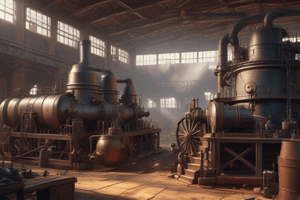Podcast
Questions and Answers
What was the outcome of the Bessemer process developed by Henry Bessemer?
What was the outcome of the Bessemer process developed by Henry Bessemer?
- It made steel stronger and more reliable than iron. (correct)
- It produced liquid copper from ores.
- It introduced a method to identify the atomic structure.
- It enhanced the manufacturing of pure iron.
Which technique was crucial in determining the size of atoms and their chemical bonds?
Which technique was crucial in determining the size of atoms and their chemical bonds?
- Extractive metallurgy
- X-ray crystallography (correct)
- The Bessemer process
- Crucible steel making
What are the three outputs from the process of extractive metallurgy?
What are the three outputs from the process of extractive metallurgy?
- Feed, concentrate, and tailings (correct)
- Crude, refined, and waste materials
- Ore, waste, and by-products
- Feed, refuse, and ore
Which historical achievement occurred first in the timeline of material science advancements?
Which historical achievement occurred first in the timeline of material science advancements?
What was a significant benefit of using steel over iron for infrastructure during the industrialization period?
What was a significant benefit of using steel over iron for infrastructure during the industrialization period?
What does the term 'Wootz steel' refer to in the context of material science?
What does the term 'Wootz steel' refer to in the context of material science?
Which of the following was a discovery made possible by X-ray crystallography?
Which of the following was a discovery made possible by X-ray crystallography?
What was the primary purpose of heating porous iron and packing it with wood chips in a clay crucible?
What was the primary purpose of heating porous iron and packing it with wood chips in a clay crucible?
Who invented modern concrete and for what primary purpose?
Who invented modern concrete and for what primary purpose?
In what year did Henry Bessemer patent his process for making steel?
In what year did Henry Bessemer patent his process for making steel?
What is a significant feature of hydraulic cement as introduced by Smeaton?
What is a significant feature of hydraulic cement as introduced by Smeaton?
What is the connection between Wootz steel and Damascus swords?
What is the connection between Wootz steel and Damascus swords?
Which element is NOT a component of early man-made glass?
Which element is NOT a component of early man-made glass?
What aspect of optical microscopy did Anton van Leeuwenhoek contribute to its history?
What aspect of optical microscopy did Anton van Leeuwenhoek contribute to its history?
Why was the first Eddystone Lighthouse constructed using wood not successful?
Why was the first Eddystone Lighthouse constructed using wood not successful?
What material gained prominence for aesthetic purposes after the 19th Century?
What material gained prominence for aesthetic purposes after the 19th Century?
What defines a material as 'glass' in scientific terms?
What defines a material as 'glass' in scientific terms?
Who were awarded the Nobel Prize in Physics for inventing the transistor?
Who were awarded the Nobel Prize in Physics for inventing the transistor?
What is the primary process involved in smelting iron?
What is the primary process involved in smelting iron?
What is the highest naturally occurring element represented in the periodic table?
What is the highest naturally occurring element represented in the periodic table?
What concept did Mendeleev introduce while organizing the periodic table?
What concept did Mendeleev introduce while organizing the periodic table?
What is a bloom in the context of smelting iron?
What is a bloom in the context of smelting iron?
Which of the following statements about the periodic table is incorrect?
Which of the following statements about the periodic table is incorrect?
What sparked the invention of the transistor at Bell Labs?
What sparked the invention of the transistor at Bell Labs?
Flashcards
Wootz Steel
Wootz Steel
A type of steel created by heating porous iron, releasing slag, and packing it with wood chips in a clay crucible to absorb carbon, leading to a strong metal suitable for tools and swords.
Damascus Swords
Damascus Swords
Famous swords made from Wootz steel, known for their distinctive wood-grain pattern.
Modern Concrete
Modern Concrete
A strong construction material invented by John Smeaton in 1755, crucial for building structures that endure harsh conditions like waves.
Hydraulic Cement
Hydraulic Cement
Signup and view all the flashcards
Portland Cement
Portland Cement
Signup and view all the flashcards
Optical Microscopy
Optical Microscopy
Signup and view all the flashcards
Glass
Glass
Signup and view all the flashcards
Early Glassmaking
Early Glassmaking
Signup and view all the flashcards
Bessemer process
Bessemer process
Signup and view all the flashcards
X-ray Crystallography
X-ray Crystallography
Signup and view all the flashcards
Extractive Metallurgy
Extractive Metallurgy
Signup and view all the flashcards
Crucible steel making
Crucible steel making
Signup and view all the flashcards
Glass
Glass
Signup and view all the flashcards
Transistor
Transistor
Signup and view all the flashcards
Smelting iron
Smelting iron
Signup and view all the flashcards
Periodic Table of Elements
Periodic Table of Elements
Signup and view all the flashcards
Atomic Number
Atomic Number
Signup and view all the flashcards
Chemical Families (Groups)
Chemical Families (Groups)
Signup and view all the flashcards
Periods
Periods
Signup and view all the flashcards
Study Notes
The Bessemer Process
- A process for melting iron, marking the start of industrialization.
- Invented by Henry Bessemer in 1856.
- Called "The Manufacture of Iron Without Fuel."
- Blows oxygen through pig iron to remove impurities.
- Resulting material is steel.
- Steel is stronger and more reliable than iron, thus improving bridges and rail tracks.
X-ray Crystallography
- A fundamental technique to view the composition of materials.
- Developed in 1912.
- Determines the size of atoms and their chemical bonds.
- Used to understand the function and structure of DNA.
- Demonstrates the hexagonal symmetry of a snowflake.
- Used to study the atomic structure of new materials.
Extractive Metallurgy
- The process of separating raw materials.
- In 5000 BC, people in modern-day Turkey discovered how to extract liquid copper from malachite and azurite.
- Discovered that molten metal can be cast into shapes.
- Essentially, the process starts with separating raw materials.
- The process outputs: feed (raw ore), concentrate (valuable metal), and tailings (waste).
Crucible Steel Making (Wootz Steel)
- Developed in India and Sri Lanka around 300 BC.
- Involves heating porous iron until very hot, hammering it to release slag, then packing the iron with wood chips in a clay crucible, and heating to absorb carbon from the wood.
- The resulting steel is known as Wootz steel (crucible steel), is the material for famous Damascus swords.
- This steel had an unusual wood-grain pattern.
Modern Concrete
- John Smeaton invented modern concrete in 1755.
- Created for building the third Eddystone Lighthouse on the English Channel.
- Needed a material to withstand waves.
- Needed a material that set quickly; hence, the 12-hour window between tides.
- "Hydraulic" mortar: water added to cement powder.
- Cemented material hardens underwater.
- Best hydraulic cements are made from specific proportions of limestone, brick powder, and fine pebbles.
- This is the beginning of modern use of cement and concrete.
- Joseph Aspdin created Portland cement later.
Optical Microscopy
- Developed by Anton van Leeuwenhoek around 1668.
- The design of the optical microscope has remained largely the same.
- Leeuwenhoek is credited with popularizing the microscope.
- The oldest known drawing made with a microscope is of bees.
Glass
- After ceramics, glass is the greatest non-metallic engineering material.
- Naturally found (volcanic glass) and used since the Stone Age for sharp cutting tools.
- First man-made forms are believed to start in Northern Syria and formally made in Iran.
- Glass includes lime, soda, and silica.
- Became more of an aesthetic art form in the 19th century (jewelry and sculpture).
- In terms of science, glass is non-crystalline material. Its atoms aren't in a lattice arrangement, and can transition from brittle to molten-like forms.
The Transistor
- Considered one of the greatest inventions of the 20th century.
- Invented by John Bardeen, Walter H. Brattain, and William Shockley at Bell Labs in 1948.
- Involved connecting gold points to a germanium crystal (semiconductor similar to silicon).
- Produced a signal with greater output power than its input.
- Awarded the 1956 Nobel Prize in Physics.
- At its core, a transistor is a semiconductor that amplifies and "switches" electrical signals.
Smelting Iron
- Egyptians were thought to be the first to smelt iron around 3500 BC.
- Considered the first significant process in metallurgy.
- The process of smelting is removing metal from its ore.
- Earliest smelting methods involved a bloomery furnace at just low enough temperatures to not melt the iron.
- The product is a spongy porous mass of iron known as a bloom.
- The bloom is hammered into desired shapes.
Periodic Table of the Elements
- Dimitri Mendeleev created the first organized periodic table in 1869.
- It is the most referenced tool in materials science.
- The modern periodic table arranges 118 elements based on their atomic number and chemical properties.
- Atomic number increases from Hydrogen to Plutonium which is the naturally occurring element with the highest number of protons in its nucleus.
- The table is useful for understanding relationships between elements and predicting properties of new elements.
- Mendeleev left gaps in the table for predicted undiscovered elements, demonstrating profound foresight.
Studying That Suits You
Use AI to generate personalized quizzes and flashcards to suit your learning preferences.




